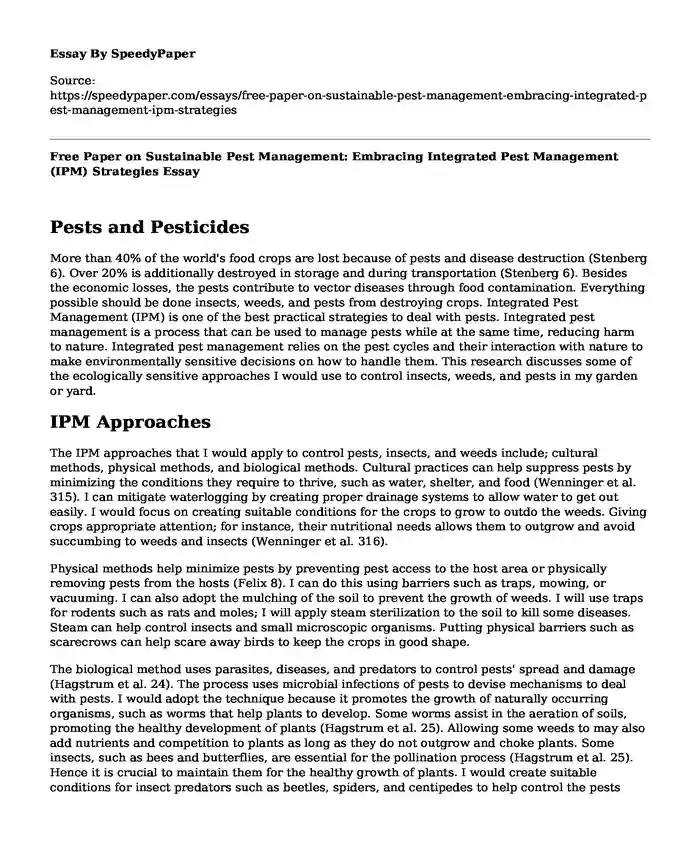
| Type of paper: | Essay |
| Categories: | Management Strategy Food Nature |
| Pages: | 3 |
| Wordcount: | 759 words |
Pests and Pesticides
More than 40% of the world's food crops are lost because of pests and disease destruction (Stenberg 6). Over 20% is additionally destroyed in storage and during transportation (Stenberg 6). Besides the economic losses, the pests contribute to vector diseases through food contamination. Everything possible should be done insects, weeds, and pests from destroying crops. Integrated Pest Management (IPM) is one of the best practical strategies to deal with pests. Integrated pest management is a process that can be used to manage pests while at the same time, reducing harm to nature. Integrated pest management relies on the pest cycles and their interaction with nature to make environmentally sensitive decisions on how to handle them. This research discusses some of the ecologically sensitive approaches I would use to control insects, weeds, and pests in my garden or yard.
IPM Approaches
The IPM approaches that I would apply to control pests, insects, and weeds include; cultural methods, physical methods, and biological methods. Cultural practices can help suppress pests by minimizing the conditions they require to thrive, such as water, shelter, and food (Wenninger et al. 315). I can mitigate waterlogging by creating proper drainage systems to allow water to get out easily. I would focus on creating suitable conditions for the crops to grow to outdo the weeds. Giving crops appropriate attention; for instance, their nutritional needs allows them to outgrow and avoid succumbing to weeds and insects (Wenninger et al. 316).
Physical methods help minimize pests by preventing pest access to the host area or physically removing pests from the hosts (Felix 8). I can do this using barriers such as traps, mowing, or vacuuming. I can also adopt the mulching of the soil to prevent the growth of weeds. I will use traps for rodents such as rats and moles; I will apply steam sterilization to the soil to kill some diseases. Steam can help control insects and small microscopic organisms. Putting physical barriers such as scarecrows can help scare away birds to keep the crops in good shape.
The biological method uses parasites, diseases, and predators to control pests' spread and damage (Hagstrum et al. 24). The process uses microbial infections of pests to devise mechanisms to deal with pests. I would adopt the technique because it promotes the growth of naturally occurring organisms, such as worms that help plants to develop. Some worms assist in the aeration of soils, promoting the healthy development of plants (Hagstrum et al. 25). Allowing some weeds to may also add nutrients and competition to plants as long as they do not outgrow and choke plants. Some insects, such as bees and butterflies, are essential for the pollination process (Hagstrum et al. 25). Hence it is crucial to maintain them for the healthy growth of plants. I would create suitable conditions for insect predators such as beetles, spiders, and centipedes to help control the pests biologically.
Human and environmental problems IPM targets to avoid
IPM reduces environmental problems associated with controlling pests by adopting eco-friendlier measures (Felix 20). The process emphasizes the use of nature-sensitive approaches in controlling pests. This helps to enhance the sustainability of soils and prevents the transfer of harmful chemicals to human bodies via the food web. IPM reduces effects on non-target species by adopting selective pest management mechanisms (Felix 20). The method allows some crucial organisms; such as worms to thrive. Worms are vital in the air aeration process. Some others, such as bees, are also vital for reproduction. IPM reduces the costs of pest management (Felix 20). Chemical fertilizers are costly, and they may be unaffordable for everyone.
Conclusion
To conclude, IPM contributes significantly to maintaining pests, weeds, and insects using simple eco-friendly measures. Controlling weeds and pests cannot be used as an excuse to degrade the environment. Some of the IPM measures that I can adopt in my garden include; cultural methods, physical methods, and biological methods. This method would help reduce impacts on nature and ensure that the products are healthy for human consumption. In the process of maximizing production, we should be considerate of our environment; hence we should adopt IPM.
Works Cited
Felix, Maria do Rosario. "Integrated Pest Management in Plant Protection." (2018). http://hdl.handle.net/10174/24291
Hagstrum, David W., and Paul W. Flinn. "Integrated pest management." Integrated Management of Insects in Stored Products. CRC Press, 2018. https://doi.org./10.1201/9780203750612-9
Stenberg, Johan A. "A conceptual framework for integrated pest management." Trends in Plant Science, vol.22, no.9, 2017, pp:759-769. https://doi.org/10.1016/j.tplants.2017.06.010
Wenninger, Erik J., et al. "Insect pests and their management." Potato Production Systems. Springer, Cham, 2020. 283-345. https://doi.org/10.1007/978-3-030-39157-7_11
Cite this page
Free Paper on Sustainable Pest Management: Embracing Integrated Pest Management (IPM) Strategies. (2023, Dec 03). Retrieved from https://speedypaper.net/essays/free-paper-on-sustainable-pest-management-embracing-integrated-pest-management-ipm-strategies
Request Removal
If you are the original author of this essay and no longer wish to have it published on the SpeedyPaper website, please click below to request its removal:
- Free Essay with CEMEX Research and Recommended Strategies
- Essay Sample on Outdoor Sporting Goods
- Oligopoly, Mergers, and Acquisitions. Essay Example
- Free Essay on How You Know What Your Customers Want?
- Essay Sample on Rewards, Benefits & Compensation: Ethical Behavior and Leadership
- Free Essay Sample: Stakeholder Engagement in Project Management
- Free Paper Example on Global Warming
Popular categories




